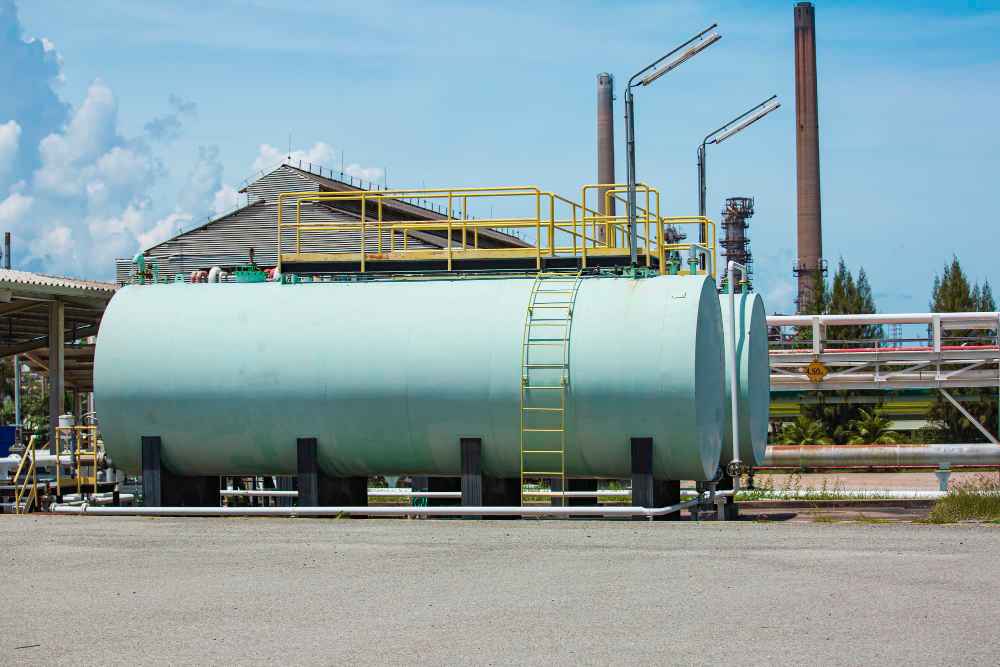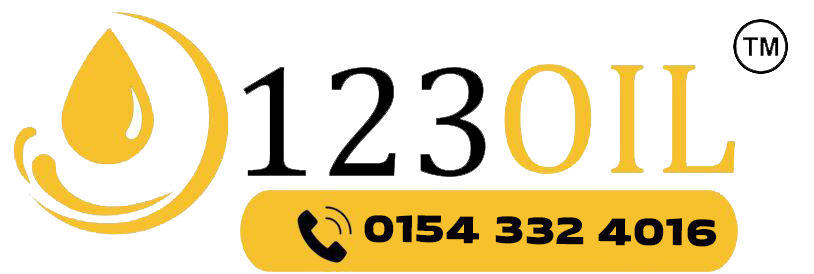The minimum oil tank distance from a house in the UK should be at least 1.8 metres from any non-fire-rated building or structure. It must also be 760mm away from boundaries and 600mm from overhanging eaves or screening. If these distances cannot be achieved, a 30-minute fire-rated barrier made from non-combustible materials should be installed. These requirements, outlined in Building Regulations Part J and OFTEC standards, ensure fire safety, environmental protection, and compliance for all domestic heating oil installations.
If your property relies on heating oil for heating and hot water, understanding the proper distance between the oil tank and the house is essential. Not only does it ensure safety, but it also keeps you compliant with building regulations and environmental standards. Incorrect installation can lead to fire hazards, leaks, or insurance complications. This guide explores everything you need to know about safe oil tank placement, required distances, regulations, and practical tips for homeowners across the UK.
Understanding Why Oil Tank Distance Matters
Heating oil is a highly efficient and cost-effective fuel, but like all combustible materials, it poses certain risks. Ensuring your oil storage tank is placed at a safe distance from your home and other structures minimises fire hazards and prevents contamination in the event of leaks or spills.
The distance between an oil tank and your house isn’t just a recommendation, it’s a legal and safety requirement under Building Regulations and the Environment Agency guidelines. Correct placement ensures that:
- The tank is protected from potential sources of fire.
- There is safe access for maintenance and refuelling.
- Oil spills or leaks don’t contaminate water supplies or soil.
- The installation complies with OFTEC (Oil Firing Technical Association) standards.
What Are the Regulations for Oil Tank Distance from the House?
In the UK, domestic heating oil tanks must comply with Building Regulations Part J, which sets minimum separation distances to prevent fire spread and protect the environment. The regulations vary slightly depending on whether your tank is plastic or metal, bunded or single-skinned, and whether it is installed above ground or underground.
Minimum Distance Requirements
According to OFTEC and Building Regulations, an above-ground oil tank should be sited:
- At least 1.8 metres away from non-fire-rated buildings or structures (such as your home, sheds, or garages).
- At least 760 millimetres away from boundaries, such as fences or walls, unless the boundary is fire-resistant for 30 minutes and extends at least 300mm above and beyond the tank on all sides.
- At least 600 millimetres away from screening (like trellis or vegetation).
- At least 1.8 metres from openings in buildings (like windows, doors, or air vents).
- At least 600 millimetres from eaves or overhanging roofs.
If these distances cannot be achieved due to space limitations, a fire protection barrier must be installed between the tank and the building or boundary.
Using Fire Protection Barriers
When your property layout makes it impossible to maintain the required separation, installing a fire-rated barrier is a safe and compliant solution.
A proper fire barrier should:
- It is constructed from non-combustible materials.
- Offer at least 30 minutes of fire resistance.
- Extend at least 300mm above and beyond the ends of the tank.
- Completely separate the tank from the house or other combustible structures.
This method is often used in smaller gardens or urban homes with limited outdoor space.
Bunded vs. Single-Skinned Oil Tanks
Your choice of oil tank also affects the installation requirements and safety considerations.
Single-Skinned Tanks
These have just one layer of protection and are not suitable for all properties. If a leak occurs, there’s no secondary containment to prevent oil from escaping into the environment. For this reason, single-skinned tanks can only be installed in locations where a spillage wouldn’t pose a pollution risk.
Bunded Tanks
A bunded tank has a secondary containment layer designed to hold at least 110% of the tank’s capacity in the event of a leak or overfill. They’re now the recommended standard for domestic installations, especially near:
- Watercourses or drains
- Conservation areas
- Sensitive ground conditions
Because they are safer, bunded tanks can often be installed in slightly more confined areas than single-skinned ones, though distance requirements should still be respected wherever possible.

Additional Distance Considerations
Besides the house, your oil tank should also maintain safe distances from other potential hazards and access points.
- Flues and chimneys: Minimum 1.8 metres from oil tanks.
- Oil delivery point: The fill point must be easily accessible for oil delivery vehicles, usually within 30 metres of the road.
- Drains and watercourses: At least 10 metres away to prevent pollution in case of a leak.
- Electrical sources: Avoid proximity to electrical cables or devices.
If your garden includes features such as garden sheds, greenhouses, or garden furniture, it’s wise to position the oil tank as far from these as possible for both safety and convenience.
Environmental Protection Regulations
The Environment Agency has strict guidelines to prevent oil pollution, which can cause serious environmental damage. If your property is near a river, stream, or pond, or if the tank could drain into a watercourse, you’ll need to ensure additional containment measures are in place.
A secondary containment system, such as a bunded tank, spill tray, or catch pit, helps to minimise risk. Additionally, you may be required to install:
- Drip trays under delivery hoses.
- Overfill prevention valves.
- Lockable fill points to prevent accidental or unauthorised access.
Installation Location: Above or Below Ground?
While most domestic tanks are installed above ground for ease of maintenance, some homeowners prefer underground tanks for aesthetic reasons or limited space.
Above-Ground Tanks
- Easier to inspect, maintain, and replace.
- More affordable installation and repair.
- Must comply with fire safety spacing regulations.
Underground Tanks
- Save space and are visually discreet.
- Require robust secondary containment and corrosion protection.
- Must be installed by certified professionals in accordance with OFTEC guidelines.
However, underground installations are more complex and costly, so they’re less common for residential use.
How to Ensure Compliance during Installation
To ensure your oil tank installation meets all legal and safety standards, it’s vital to hire a qualified and certified technician. In the UK, an OFTEC-registered installer can:
- Assess your property’s layout and advise on the best location.
- Ensure compliance with Building Regulations Part J.
- Certify the installation to save you the hassle of seeking separate Building Control approval.
A professional will also ensure that your tank is installed on a non-combustible, level base such as concrete or paving slabs. This base should extend at least 300mm beyond the tank’s footprint on all sides.
Routine Maintenance and Inspection
Once your oil tank is safely installed, regular maintenance helps keep it secure and efficient. You should:
- Inspect the tank visually every month for cracks or rust.
- Check for oil odours or signs of leaks around the base.
- Ensure the vent and gauge are working correctly.
- Have an annual inspection by an OFTEC technician.
Routine servicing not only extends the tank’s lifespan but also keeps you compliant with your insurance policy and environmental standards.
Planning Permission and Building Regulations
Most domestic oil tanks don’t require planning permission, provided they meet certain conditions:
- Capacity under 3,500 litres.
- Located in the rear garden (not in front of the property).
- Compliant with Building Regulations and fire safety distances.
If your home is a listed building or located in a conservation area, additional permissions may be necessary. Always check with your local planning authority before installation.
Safety Tips for Homeowners
To keep your oil heating system safe and efficient:
- Never smoke or use open flames near the tank.
- Keep vegetation trimmed around the area to prevent fire risk.
- Install a tank lock to prevent theft or vandalism.
- Ensure good ventilation around the tank for heat dissipation.
- Monitor your oil level regularly to avoid running out, as this can damage the heating system.
For emergencies, always have your supplier’s contact details on hand, 123 Oil can provide professional delivery and safety advice to keep your system running smoothly.
Common Mistakes to Avoid
Many homeowners unknowingly breach regulations due to simple oversights. Avoid these frequent mistakes:
- Placing the tank too close to the house or boundaries.
- Installing the tank on uneven or combustible ground.
- Ignoring the need for a bunded tank near water sources.
- Blocking access for maintenance or delivery.
- Failing to install a fire barrier in confined spaces.
Taking the time to plan your tank location properly can save you from fines, insurance issues, and costly remediation.
Final Thoughts
Proper placement of your heating oil tank is not just about compliance, it’s about ensuring safety, efficiency, and environmental responsibility. The minimum distance between the oil tank and the house in the UK is 1.8 metres, but your exact setup may vary depending on site conditions, tank type, and fire safety requirements. Always follow OFTEC guidelines, consult professionals, and never compromise on quality or safety.
A well-sited and maintained oil tank provides peace of mind and efficient heating for years to come.
Frequently Asked Questions
An oil tank should be placed at least 1.8 metres away from your house or any non-fire-rated structure. This distance helps prevent fire spread and complies with Building Regulations Part J. If you can’t maintain this distance, a 30-minute fire-rated barrier must be installed between the tank and the house.
You can, but only if the boundary wall is fire-resistant for at least 30 minutes and extends 300mm above and beyond the tank on all sides. Otherwise, your tank must be at least 760mm away from any boundary or fence to comply with UK regulations.
If your garden is small, you can install a fire-protected barrier made of non-combustible materials such as brick or concrete. This allows you to safely position the tank closer to your house or boundary without breaking regulations.
Generally, no planning permission is required for domestic oil tanks with a capacity of less than 3,500 litres, provided they meet all distance and safety requirements. However, if your property is listed or in a conservation area, it’s best to check with your local council before installation.
Always use an OFTEC-registered installer to ensure your oil tank meets all safety and environmental regulations. They’ll assess your property, advise on safe distances, and certify the installation, ensuring full compliance with Building Regulations Part J and ecological standards.










